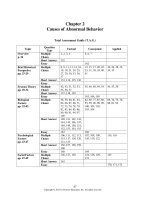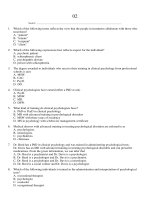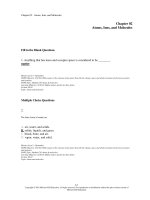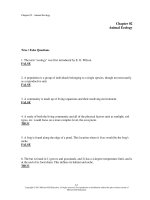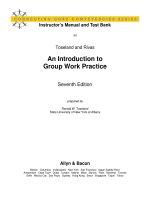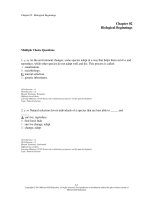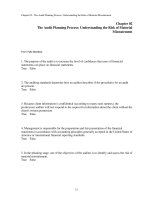Launching new ventures an entrepreneurial approach 7th edition allen test bank
Bạn đang xem bản rút gọn của tài liệu. Xem và tải ngay bản đầy đủ của tài liệu tại đây (183.23 KB, 10 trang )
True / False
1. Entrepreneurship is a personal journey that begins in the mind of the nascent entrepreneur.
a. True
b. False
ANSWER:
True
POINTS:
1
REFERENCES: Preparing for the Entrepreneurial Journey, Intro
2. Research has enabled us to identify the characteristics of the typical entrepreneur. .
a. True
b. False
ANSWER:
False
POINTS:
1
REFERENCES: 2.1 Saying Goodbye to Stereotypes
3. The chances of success for a new business startup are determined primarily by the size of the initial financial
investment.
a. True
b. False
ANSWER:
False
POINTS:
1
REFERENCES: 2.1 Saying Goodbye to Stereotypes
4. In an entrepreneurial endeavor, risk is correlated with reward; that is, the greater the risk taken, the greater the reward
expected.
a. True
b. False
ANSWER:
False
POINTS:
1
REFERENCES: 2.1 Saying Goodbye to Stereotypes
5. Research has determined that effective and efficient business planning correlates with business success.
a. True
b. False
ANSWER:
False
POINTS:
1
REFERENCES: 2.1 Saying Goodbye to Stereotypes
6. Entrepreneurship is for those under 30, not for older persons.
a. True
b. False
ANSWER:
False
POINTS:
1
REFERENCES: 2.1 Saying Goodbye to Stereotypes
7. The most important element for success is abundant start-up capital.
Cengage Learning Testing, Powered by Cognero
Page 1
a. True
b. False
ANSWER:
False
POINTS:
1
REFERENCES: 2.1 Saying Goodbye to Stereotypes
8. Today many enterprising people are turning to nonprofit ventures to realize their entrepreneurial dreams.
a. True
b. False
ANSWER:
True
POINTS:
1
REFERENCES: 2.2 Paths to Entrepreneurship
9. Home-based businesses do not qualify as “entrepreneurship.”
a. True
b. False
ANSWER:
False
POINTS:
1
REFERENCES: 2.2 Paths to Entrepreneurship
10. One of the biggest problems that scientists and engineers face when they decide to consider entrepreneurship is the
expectation that there should be formulas and straightforward "right or wrong" answers.
a. True
b. False
ANSWER:
True
POINTS:
1
REFERENCES: 2.3 The Challenges and Opportunities of Entrepreneurship
Multiple Choice
11. All of entrepreneurship can be reduced to:
a. wealth
b. independence
c. growth
d. people
e. partnership
ANSWER:
d
POINTS:
1
REFERENCES: Preparing for the Entrepreneurial Journey, Intro
12. What’s more important than start-up capital is:
a. size of the team
b. size of the market
c. amount of startup capital
d. the amount of all resources
e. desire for independence
ANSWER:
d
Cengage Learning Testing, Powered by Cognero
Page 2
POINTS:
1
REFERENCES: 2.1 Saying Goodbye to Stereotypes
13. Most of the great businesses that have been successful for at least 50 years (companies such as Walt Disney, Sony,
and Merck) did not start with a/an:
a. lot of money
b. need for independence
c. great idea
d. great team
e. original idea
ANSWER:
c
POINTS:
1
REFERENCES: 2.1 Saying Goodbye to Stereotypes
14. The goal of most entrepreneurs is to reduce the level of ____ in any venture.
a. investment
b. independence
c. planning
d. risk
e. resources
ANSWER:
d
POINTS:
1
REFERENCES: 2.1 Saying Goodbye to Stereotypes
15. In general, venture capitalists say that they will take a ____ and a large market opportunity in a fast-growing area over
a great idea any day
a. big risk
b. strong business plan
c. passionate entrepreneur
d. strong leader
e. great team
ANSWER:
e
POINTS:
1
REFERENCES: 2.1 Saying Goodbye to Stereotypes
16. The Kauffman Index of Entrepreneurial Activity from 1996-2011 found that men and women in the ____ age bracket
were responsible for more than 20% of all the entrepreneurial activity in the United States.
a. 25-45
b. 25-55
c. 18-43
d. 55-64
e. 65-98
ANSWER:
d
POINTS:
1
REFERENCES: 2.1 Saying Goodbye to Stereotypes
17. Peter Drucker asserted, "The entrepreneurial mystique, it's not magic, it's not mysterious, and it has nothing to do with
Cengage Learning Testing, Powered by Cognero
Page 3
the genes. It is ____."
a. having enough money
b. a great idea
c. a great network
d. discipline
e. the need for independence
ANSWER:
d
POINTS:
1
REFERENCES: 2.1 Saying Goodbye to Stereotypes
18. In the United States, ____ entrepreneurship is most prevalent.
a. opportunity-driven
b. efficiency-driven
c. factor-driven
d. necessity-driven
e. passion-driven
ANSWER:
d
POINTS:
1
REFERENCES: 2.2 Paths to Entrepreneurship
19. ____ comprise over fifty percent of all small businesses in the United States.
a. Startups
b. Home-based businesses
c. Nonprofit businesses
d. Serial entrepreneurs
e. Corporate entrepreneurs
ANSWER:
b
POINTS:
1
REFERENCES: 2.2 Paths to Entrepreneurship
20. An entrepreneur who owns a minority or majority stake in several ventures is called a ____ entrepreneur.
a. portfolio
b. traditional
c. serial
d. nonprofit
e. None of these choices
ANSWER:
a
POINTS:
1
REFERENCES: 2.2 Paths to Entrepreneurship
21. An entrepreneur who starts one business and then moves on to start another is classified as a ____ entrepreneur.
a. portfolio
b. traditional
c. serial
d. nonprofit
e. None of these choices
Cengage Learning Testing, Powered by Cognero
Page 4
ANSWER:
c
POINTS:
1
REFERENCES: 2.2 Paths to Entrepreneurship
22. An entrepreneur may form a nonprofit venture for achieving goals associated with:
a. Education
b. Religion
c. Charitable
d. Any or all of these choices.
e. None of these choices.
ANSWER:
d
POINTS:
1
REFERENCES: 2.2 Paths to Entrepreneurship
23. Robert Chambers used the ____ organizational structure as a vehicle to help low-income people make better
purchasing decisions when it came to cars.
a. new venture
b. socially responsible
c. startup
d. corporate
e. nonprofit
ANSWER:
e
POINTS:
1
REFERENCES: 2.2 Paths to Entrepreneurship
24. Entrepreneurial-like ventures inside large companies may be formed using:
a. Opportunistic models
b. Enabler models
c. Advocate models
d. Producer models
e. All of these choices.
ANSWER:
d
POINTS:
1
REFERENCES: 2.2 Paths to Entrepreneurship
25. As relevant in corporate entrepreneurships as in independent ones are:
a. Recognizing opportunities
b. Conducting feasibility analyses
c. Developing execution plans
d. All of these choices
e. None of these choices
ANSWER:
d
POINTS:
1
REFERENCES: 2.2 Paths to Entrepreneurship
26. A very helpful exchange of information and resources can be gained from groups or organizations who form a:
Cengage Learning Testing, Powered by Cognero
Page 5
a. network
b. mentor
c. self-starter
d. leader
e. All of these choices
ANSWER:
a
POINTS:
1
REFERENCES: 2.4 Preparing to Become an Entrepreneur
27. Because entrepreneurs operate in a world of uncertainty, they need to learn to:
a. Analyze a situation
b. Extract the important information
c. Ignore the superfluous information
d. Compare potential outcomes
e. All of these choices
ANSWER:
e
POINTS:
1
REFERENCES: 2.4 Preparing to Become an Entrepreneur
28. ____ is the exchange of information and resources among individuals, groups, or organizations whose common goals
are to mutually benefit and create value for the members.
a. Business planning
b. Marketing
c. Mentoring
d. Networking
e. None of these choices
ANSWER:
d
POINTS:
1
REFERENCES: 2.4 Preparing to Become an Entrepreneur
29. The ____ in a professional network are the entrepreneur's acquaintances and business contacts.
a. strong ties
b. weak ties
c. work ties
d. partners
e. mentors
ANSWER:
b
POINTS:
1
REFERENCES: 2.4 Preparing to Become an Entrepreneur
30. Entrepreneurs rely on their ____ for objective advice because they are not biased by a prior history with the
entrepreneur.
a. strong ties
b. weak ties
c. work ties
d. partners
Cengage Learning Testing, Powered by Cognero
Page 6
e. mentors
ANSWER:
b
POINTS:
1
REFERENCES: 2.4 Preparing to Become an Entrepreneur
31. ____ serve as gateways to other networks, exerting influence between groups or networks rather than within groups.
a. Network brokers
b. Angel investors
c. Gateways
d. Opinion leaders
e. All of these choices
ANSWER:
a
POINTS:
1
REFERENCES: 2.4 Preparing to Become an Entrepreneur
32. Which of the following is not a barrier to becoming self-employed?
a. Lack of confidence
b. Financial needs
c. Family issues
d. Time constraints
e. Lack of training
ANSWER:
e
POINTS:
1
REFERENCES: 2.4 Preparing to Become an Entrepreneur
33. ____ is a critical part of the everyday life of an entrepreneur and is a skill that must be developed and exercised
carefully.
a. Making effective decisions
b. Paying attention to details
c. Comparing potential outcomes
d. Critical thinking
e. Being a micromanager
ANSWER:
a
POINTS:
1
REFERENCES: 2.4 Preparing to Become an Entrepreneur
34. ____ facilitates a new venture's identity and legitimacy as well as creates a competitive advantage that is difficult to
replicate.
a. Networking
b. Decision making
c. Storytelling
d. Critical thinking
e. Micromanaging
ANSWER:
c
POINTS:
1
REFERENCES: 2.4 Preparing to Become an Entrepreneur
Cengage Learning Testing, Powered by Cognero
Page 7
35. When all is said and done, business is about:
a. Critical skills
b. Research
c. relationships
d. Management skills
e. All of these choices
ANSWER:
c
POINTS:
1
REFERENCES: 2.4 Preparing to Become an Entrepreneur
36. Entrepreneurial leaders have a distinct advantage over ____ leaders because they see themselves as part of a team.
a. heroic
b. charismatic
c. visionary
d. both "heroic" and "charismatic"
e. both "charismatic" and "visionary"
ANSWER:
d
POINTS:
1
REFERENCES: 2.4 Preparing to Become an Entrepreneur
37. One of the best ways to discover an opportunity is to study a/an ____ in depth.
a. company
b. product
c. industry
d. leader
e. None of these choices
ANSWER:
c
POINTS:
1
REFERENCES: 2.4 Preparing to Become an Entrepreneur
38. Essential to creating an opportunity in a complex world, entrepreneurs must embrace:
a. Networking
b. Research
c. Uncertainty
d. Decision-making
e. strategic alliances / acquisition
ANSWER:
c
POINTS:
1
REFERENCES: 2.4 Preparing to Become an Entrepreneur
39. An entrepreneur's ____ are the foundation for the business and are always reflected in the business and in the way
customers are treated.
a. ideas
b. networks
c. core values
d. resources
Cengage Learning Testing, Powered by Cognero
Page 8
e. relationships
ANSWER:
c
POINTS:
1
REFERENCES: 2.4 Preparing to Become an Entrepreneur
40. A/An ____ is a group of companies that are engaged in similar or related activities.
a. network
b. industry
c. foreign market
d. both "network" and "industry"
e. None of these choices
ANSWER:
b
POINTS:
1
REFERENCES: 2.4 Preparing to Become an Entrepreneur
Subjective Short Answer
41. Why have myths developed about entrepreneurs?
ANSWER:
Entrepreneurs make up a relatively small portion of the population. They have the potential to become
very rich and the potential to lose large sums of money. The media give them disproportionate coverage
because of the risks and potential rewards and because they are different from most managers. Myths
develop as people try to understand the "art" of entrepreneurship.
POINTS:
1
REFERENCES: 2.1 Saying Goodbye to Stereotypes
42. Discuss the home-based entrepreneur.
ANSWER:
Home-based entrepreneurs can be found in retail, services, health care, and literally any other industry.
They represent 52 percent of all small business, and many of these are hobby businesses, consulting, and
freelance-type businesses, but some compete in the same arena as brand name businesses with large
facilities. Home-based business owners can tap into more resources than ever before from their desktops
or mobile devices to locate help for any problem they may be facing, from finding business forms to
seeking legal advice to learning how to start and run a business. In addition, U.S. tax laws have become
friendlier to home-based business owners, who can take a deduction for their home office space and
appropriate business expenses.
POINTS:
1
REFERENCES: 2.1 Saying Goodbye to Stereotypes
43. What is required for an entrepreneurial mindset to succeed inside a large corporation?
ANSWER:
Senior management commitment, a champion or several champions, corporate interoperability, clearly
defined stages and metrics, a superior team, and a spirit of entrepreneurship.
POINTS:
1
REFERENCES: 2.2 Paths to Entrepreneurship
44. Discuss some of the challenges in following the entrepreneur career path.
ANSWER:
Some challenges including finding the right business opportunity; needing to work without pay for long
hours; uncertainty; making major decisions that affect other people's lives; relying on other people; no
previous experience; facing failure; finding the right people to grow the business; dealing with a sense of
isolation; and raising capital and other resources.
POINTS:
1
Cengage Learning Testing, Powered by Cognero
Page 9
REFERENCES: 2.3 The Challenges and Opportunities of Entrepreneurship
45. What are the steps to increasing success as an entrepreneur?
ANSWER:
Some steps include find a mentor; build a network; learn about entrepreneurs; identify reasons for
wanting to own a business; analyze personality and business preferences; improve or acquire critical
skills; and study an industry.
POINTS:
1
REFERENCES: 2.3 The Challenges and Opportunities of Entrepreneurship
46. What are some sources of business knowledge for entrepreneurs? Which is the most important?
ANSWER:
Some sources are magazines, books, newspapers, college courses, life experience, job experience,
marketing research, and other entrepreneurs. The most important source is the other entrepreneurs.
POINTS:
1
REFERENCES: 2.3 The Challenges and Opportunities of Entrepreneurship
47. How can an entrepreneur efficiently build a large, but meaningful network?
ANSWER:
Entrepreneurs accomplish this by connecting with network brokers who serve as gateways to other
networks. These brokers, or opinion leaders, exert influence between groups or networks rather than
within groups.
POINTS:
1
REFERENCES: 2.4 Preparing to Become an Entrepreneur
48. In what ways do entrepreneurial leaders have an advantage over heroic leaders?
ANSWER:
Heroic leaders are lonely, without peers or teammates. Entrepreneurial leaders are, more than ever, part
of a creative team. The leader needs to inspire others to motivate and lead as well.
POINTS:
1
REFERENCES: 2.4 Preparing to Become an Entrepreneur
49. Discuss the importance of making effective decisions.
ANSWER:
Making effective decisions is a critical part of the everyday life of an entrepreneur and is a skill that must
be developed and exercised carefully. Poor decisions about hiring, business location, investors, and
strategic partners can cost a company a great deal of money and prevent it from achieving its goals. Wise
decisions, even in times of crisis, can provide an opportunity for growth.
POINTS:
1
REFERENCES: 2.4 Preparing to Become an Entrepreneur
50. Why should someone who is considering starting a business be concerned about her or his health?
ANSWER:
We should all be concerned about our health, but especially before a life-changing event of our own
choosing. Good physical, emotional, and spiritual health provides more energy for the entrepreneur,
enables her or him to deal with stress better, and clarifies the values at the foundation of the business.
POINTS:
1
REFERENCES: 2.4 Preparing to Become an Entrepreneur
Cengage Learning Testing, Powered by Cognero
Page 10
